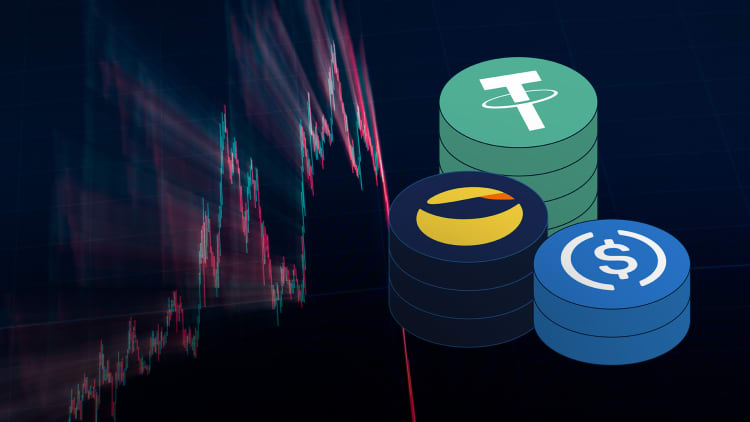Crypto startup Ripple is the latest major player to jump into the $150 billion stablecoin market with the launch of a digital currency pegged to the U.S. dollar.
The stablecoin will always be backed 1-to-1 by an equivalent sum of assets — U.S. dollar deposits, U.S. government bonds and cash equivalents — that the company holds in reserve, according to Ripple.
The crypto firm said its reserves would be accounted for in publicly available monthly attestation reports. It did not say which firm will audit.
Ripple is first launching its stablecoin in the U.S., but didn’t rule out offering additional regional products in non-U.S. markets, like Europe and Asia.
The move would pit Ripple against stablecoin giants like Tether, which is behind the largest stablecoin UDST, and USDC issuer Circle.
Payments giant PayPal, meanwhile, launched its own U.S. dollar stablecoin called PayPal USD, a stablecoin backed by U.S. dollars and dollar equivalents that is issued by crypto firm Paxos.
But Ripple CEO Brad Garlinghouse said he’s not deterred by the competition. “This market will look different [in future], certainly based on size,” he told CNBC in an interview this week.
Why Ripple’s launching a stablecoin
Garlinghouse said that the company decided to introduce a stablecoin to the market last year in response to the “depegging” of rival firms Tether’s USDT token and Circle’s USDC.
USDT temporarily lost its $1 peg in 2022 amid market instability resulting from the collapse of terraUSD, a popular so-called “algorithmic” stablecoin.
USDC also temporarily slipped below $1 in 2023 after revealing exposure to the collapsed tech-focused lender Silicon Valley Bank.
Some critics dispute the source of Tether’s reserves, and have doubts about whether company is sufficiently capitalized to survive a “bank run.”
For its part, Tether says its token is fully backed by quality reserves and has always been able to meet withdrawals, even in times of distress.
Garlinghouse said that there’s “some uncertainty” about the current market leader among U.S. regulators, without disclosing a name. He argued that Ripple is a regulated institution with licenses in New York, Ireland, and Singapore, among other countries.
Tether is the market leader for stablecoins with a market capitalization of $106.3 billion, according to CoinGecko data. The company was not immediately available for comment.
Tether is registered with FinCEN, the U.S. financial crimes watchdog, which is not the same as being regulated. The business is required to submit suspicious transaction reports and reports for deals totalling more than $10,000.
Not giving up on XRP
A Ripple stablecoin would also serve a purpose the crypto giant touts as part of its On-Demand Liquidity product, which aims to settle transactions rapidly between banks and other financial firms using the XRP token as a “bridge” currency.
Ripple has faced obstacles in finding a use case for Ripple with banks and payment firms.
Santander initially wanted to use XRP for cross-border payments, but chose not to after finding Ripple wasn’t active in enough markets yet to support its needs.
MoneyGram ended a partnership to use XRP for cross-border transfers after citing increased costs associated with the need for partnerships with exchanges and other necessary counterparties in local markets.
Garlinghouse insisted that Ripple hasn’t given up on XRP as a payment token and that stablecoins would serve as more of a complementary product for the XRP ecosystem.

“We’ve been using stablecoins in our payment flows for years,” he said. “This is not a new thing for us.”
He added that other so-called “Layer 1” protocols — blockchain networks with their own tokens — have launched stablecoins and logged growth in overall volume and liquidity.
“Our view is, having pools of liquidity that are native to the XRP ledger, they complement and help grow the XRP ecosystem,” Garlinghouse told CNBC. “In fact, the number one request we get from the XRP community is to launch a USD-backed stablecoin on the XRP Ledger.”
XRP is up around 13% in the last 12 months, according to CoinGecko data, and is currently trading at about 57 cents.
Expecting SEC settlement in the ‘millions’
The U.S. Securities and Exchange Commission in 2020 hit Ripple with a lawsuit, claiming the company illegally sold XRP to investors when it should have registered the transactions with the regulator.
A court judge recently ruled XRP is not in and of itself a security, but said that sales to institutions should be counted as unlawful securities sales.
The blockchain company sold $728.9 million worth of its XRP token to hedge funds and other sophisticated buyers, according to the U.S. District Court for the Southern District of New York.
The SEC is seeking $2 billion from Ripple as part of its lawsuit.
Garlinghouse said that what the SEC is asking for is unreasonable, as it only pertains to the $728.9 million of XRP the company sold to institutions.
He expects the total settlement to be a fraction of that in the “millions,” rather than in the billions, of dollars.
The SEC was not immediately available for comment.
WATCH: What is DeFi, and could it upend finance as we know it?

Read the full article here







